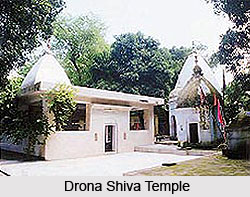 Drona Shiva Temple is a medieval temple, located in Shiva Baadi in Ambota village in Solan district of Himachal Pradesh. The shrine is placed atop a small hillock, bounded by dense woods. The presiding deity is Lord Shiva, revered in the form of a `shivling` (phallus, symbolic representation of the Lord). The shivling is assumed to have been established by Guru Dronacharya, 5000 years ago. Legends speak the Guru Dronacharya`s little daughter use to worship Lord Shiva in the spot. The girl soon obtained the benedictions of the Lord and a temple was erected at the same place by Dronacharya. Two rows of samadhis (the final state of bliss attained by yogis when they abandon the physical body to fuse with God) are visible on the far side of the Drona Shiva Temple patio and are devoted to sages Gangagiri, Ichchagiri, Tameshwargiri, Somagiri and Harigiri. In order to reach Ambota, the nearest railhead is Solan Railway Station.
Drona Shiva Temple is a medieval temple, located in Shiva Baadi in Ambota village in Solan district of Himachal Pradesh. The shrine is placed atop a small hillock, bounded by dense woods. The presiding deity is Lord Shiva, revered in the form of a `shivling` (phallus, symbolic representation of the Lord). The shivling is assumed to have been established by Guru Dronacharya, 5000 years ago. Legends speak the Guru Dronacharya`s little daughter use to worship Lord Shiva in the spot. The girl soon obtained the benedictions of the Lord and a temple was erected at the same place by Dronacharya. Two rows of samadhis (the final state of bliss attained by yogis when they abandon the physical body to fuse with God) are visible on the far side of the Drona Shiva Temple patio and are devoted to sages Gangagiri, Ichchagiri, Tameshwargiri, Somagiri and Harigiri. In order to reach Ambota, the nearest railhead is Solan Railway Station.
This article is a stub. You can enrich by adding more information to it. Send your Write Up to content@indianetzone.com





















